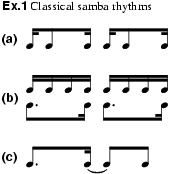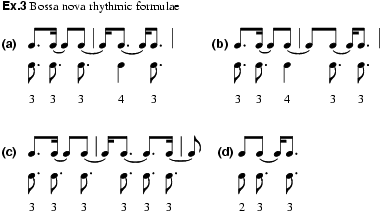In Brazilian popular music, a movement that originated about 1958–9 and effected radical stylistic changes in the classical urban Samba. The word ‘bossa’, from Rio de Janeiro slang, means loosely ‘special ability’, ‘shrewdness’, ‘astuteness’ and the like. The term ‘bossa-nova’ first appeared in Antônio Carlos Jobim’s song Desafinado (1959) whose melody with complex intervals (diminished 4ths, minor 6ths) and a rather tortuous shape was intended to suggest the idea of a singer with a certain vocal insecurity. Its melodic and harmonic complexity was justified by the song text as ‘bossa nova’. The originators of the new style included Jobim himself as a composer and João Gilberto primarily as a singer and guitarist. Their first important recording was Chega de Saudade (March 1959). Although the samba figured prominently in their repertory it was not their exclusive genre.
One
of the features of the new style, affecting popular music in general, and the
samba in particular, was a deliberate avoidance of the predominance of any
single musical parameter. Before bossa nova the melody was generally strongly
emphasized, to satisfy the basic requirement of an easily singable tune; bossa
nova, however, integrates melody, harmony and rhythm. The performer has a vital
role in this integration, but heavy emphasis on the singer’s personality is
altogether avoided. Strongly contrasting effects, loudness of voice, fermatas
or scream-like high pitches are generally excluded from a proper bossa nova
singing style; the singing should flow in a subdued tone almost like the normal
spoken language. The characteristic nasal vocal production of bossa nova is a
peculiar trait of the cabaclo folk tradition of north-eastern Brazil,
but was rare in earlier urban music. As a soloist the interpreter no longer
opposes the accompanying ensemble: they are reconciled. The guitar as an
accompanying instrument is emphasized and, whether as a solo or accompanying
instrument, may present a harmonic structure with two functions: one of
traditional harmonic support, and the other a percussive function, stressing
the rhythmic strokes chordally. Both functions are frequently integrated in the
same chord entity, as shown in many performances of Baden Powell, Brazil’s
foremost guitarist in the 1960s. Certain harmonic formulae have almost become
clichés since the advent of bossa nova, such as the shifting of major and minor
modes in a tonic–dominant relationship (e.g. A![]() minor to D
minor to D![]() major). The pattern of modulations is the opposite of
those in jazz, which usually follow an ascending order in the circle of 5ths
and have greater harmonic tension. Except for certain processes of chord
formation (particularly altered chords) there is less jazz influence than some
early critics believed. A trait traceable to jazz and perhaps related to bebop
is the highly improvised style on an implied theme of some bossa nova
instrumental pieces. The most remarkable innovation of bossa nova music is in
its rhythmic structure, which affects the very foundation on which the samba
was built. The rhythmic structure of the bossa nova samba possibly had its
origin in both the folk and the classical samba formulae (ex.1). João Gilberto was mainly
responsible for extracting and isolating those elements that constitute his
famous guitar stroke, called in Portuguese ‘violão gago’ (‘stammering guitar’; ex.2). Many variants of that basic
rendering have developed, their common trait being the predominance of ternary
divisions against the binary one which occurs only once (exx.3a, b and d) or not at all (ex.3c). These variants have been the point of departure for many
ingenious drummers and guitarists towards a previously unknown rhythmic
versatility. Bossa nova song texts are also innovatory, and are valued not only
for their expressive content but also for the sonorous individuality of their
words. Some affinity has been noticed between bossa nova texts and Brazilian
concrete poetry. In several examples the lyrics seem to have been conceived
together with the music, so close are the verbal rhythm and the melodic (cf
Jobim’s Samba de uma nota só, Desafinado and A garota de
Ipanema).
major). The pattern of modulations is the opposite of
those in jazz, which usually follow an ascending order in the circle of 5ths
and have greater harmonic tension. Except for certain processes of chord
formation (particularly altered chords) there is less jazz influence than some
early critics believed. A trait traceable to jazz and perhaps related to bebop
is the highly improvised style on an implied theme of some bossa nova
instrumental pieces. The most remarkable innovation of bossa nova music is in
its rhythmic structure, which affects the very foundation on which the samba
was built. The rhythmic structure of the bossa nova samba possibly had its
origin in both the folk and the classical samba formulae (ex.1). João Gilberto was mainly
responsible for extracting and isolating those elements that constitute his
famous guitar stroke, called in Portuguese ‘violão gago’ (‘stammering guitar’; ex.2). Many variants of that basic
rendering have developed, their common trait being the predominance of ternary
divisions against the binary one which occurs only once (exx.3a, b and d) or not at all (ex.3c). These variants have been the point of departure for many
ingenious drummers and guitarists towards a previously unknown rhythmic
versatility. Bossa nova song texts are also innovatory, and are valued not only
for their expressive content but also for the sonorous individuality of their
words. Some affinity has been noticed between bossa nova texts and Brazilian
concrete poetry. In several examples the lyrics seem to have been conceived
together with the music, so close are the verbal rhythm and the melodic (cf
Jobim’s Samba de uma nota só, Desafinado and A garota de
Ipanema).



During the early to mid-1960s bossa nova became linked with a social protest movement. Musically the introduction of international pop styles, especially rock music from England and the USA, gave rise to a dynamic hybrid style which reached its peak with the group Tropicália.
See Latin America, §IV, and Brazil, §II.
A. Ramalho Neto: Historinha do desafinado (Rio de Janeiro, 1965)
J.R. Tinhorão: Música popular: um tema em debate (Rio de Janeiro, 1966)
A. de Campos, ed.: Balanço da bossa (São Paulo, 1968)
B. Rocha Brito: ‘Bossa nova’, Balanço da bossa, ed. A. de Campos (São Paulo, 1968), 13
G. Béhague: ‘Bossa and Bossas: Recent Changes in Brazilian Urban Popular Music’, EthM, xvii (1973), 209–33
M. Budds: Jazz in the Sixties (Iowa City, IA, 1978)
J.S. Roberts: The Latin Tinge (New York, 1979, 2/1999)
J.S. Roberts: Latin Jazz (New York, 1999)
GERARD BÉHAGUE